You'll find bulk conductive storage containers priced between $3.43 and $96.59, with significant savings available through volume purchases. Key price breaks occur at 10, 50, 100, 250, and 500+ units, offering discounts up to 32% off standard rates. Container size, material quality, and ESD protection level directly impact costs, with larger units and specialized features commanding premium prices. Your industry requirements, such as aerospace or electronics specifications, will affect final pricing. Strategic ordering and proper timing can maximize your cost savings, while shipping zones and handling requirements influence total expenses. The complete pricing structure reveals additional ways to optimize your investment.
Cost Factors for Bulk Orders
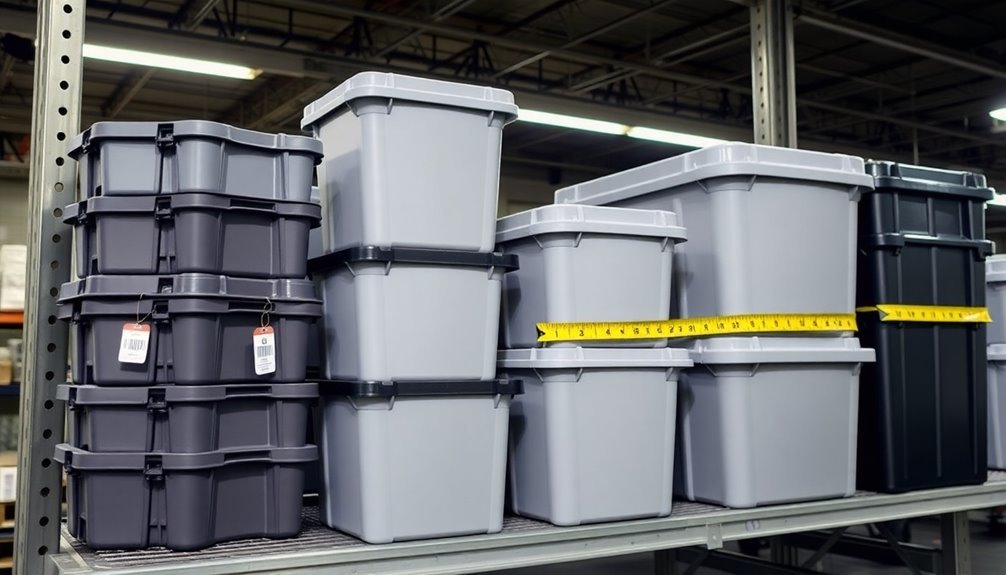
Market conditions will affect your bulk purchase pricing. Steel prices, fuel costs, and seasonal demand fluctuations directly impact container costs.
You'll benefit from tiered pricing structures, where larger orders often qualify for volume discounts. High cube containers command premium rates compared to standard units.
Keep in mind that economic conditions and regional market variations can cause prices to shift, so timing your purchase strategically can lead to significant savings.
Volume Discount Price Tiers
You'll find significant cost savings when ordering conductive bulk containers in higher quantities, with base prices ranging from $1,000-$5,000 per unit dropping by up to 40% for large orders.
These UN 31 HA1/Y certified containers offer superior safety compliance while still qualifying for volume discounts at higher quantities.
The key breakpoints occur at 11 units (10-20% off), 51 units (20-30% off), and 101+ units (30% or more off), making it worthwhile to consolidate your purchases to reach these thresholds.
Your savings potential increases dramatically as you move through the tiers, with custom orders offering even more flexibility for high-volume purchases.
Bulk Order Price Ranges
Understanding bulk order pricing structures is essential for businesses looking to optimize their storage container costs. You'll find that prices decrease substantially as your order quantities increase across five distinct tiers.
For orders of 1-49 units, you'll pay premium pricing, but you can secure better rates by moving into higher volume tiers. These high-quality containers feature ESD conductive properties that make them ideal for sensitive materials storage.
When you order 50-99 units, you'll see a moderate price reduction, while orders of 100-249 units offer even more substantial savings. The real cost benefits emerge in Tier 4 (250-499 units) and Tier 5 (500+ units), where you'll access the most competitive pricing points.
While these larger orders require higher initial investment, they typically deliver better long-term value.
Your final costs will also depend on specific factors like material type, container size, and complexity. You'll need to take into account that larger or more intricate containers generally command higher prices.
For specialized requirements, you can often negotiate custom pricing with vendors, especially for large-volume orders. Remember that while bulk purchases require more upfront capital, they'll usually reduce your per-unit costs and minimize ongoing labor expenses for shipping and receiving.
Quantity Breakpoint Benefits
Beyond standard bulk pricing, quantity breakpoint benefits create significant value for both suppliers and buyers. When you purchase conductive storage containers in larger quantities, you'll benefit from long-term cost reductions and more predictable budgeting for your operation. Customer satisfaction rates typically increase with quantity break pricing.
These volume discounts simplify your purchasing process while strengthening your supplier relationships.
For suppliers, quantity breakpoints drive higher-volume purchases, reducing warehousing costs and improving inventory turnover. They'll serve you more efficiently when you order in larger quantities less frequently, leading to enhanced operational efficiency and reduced logistics costs. This efficiency translates to better pricing tiers for your business.
To maximize these benefits, you'll need to analyze the breakpoints strategically. Consider using CPQ software to calculate the best order quantities and evaluate potential savings.
You should also assess your storage capacity and inventory management capabilities before committing to larger orders. By understanding the economies of scale in play, you can determine which quantity breakpoints align best with your operational needs while maintaining a healthy balance between storage costs and volume discounts.
This approach guarantees you're optimizing your investment in conductive storage containers.
Container Size and Price Correlation
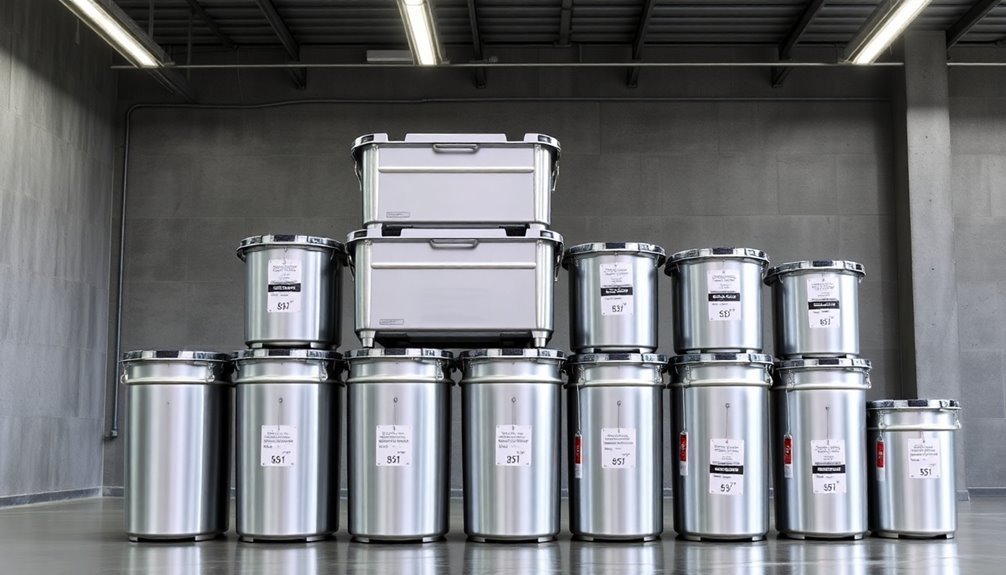
The relationship between container size and price follows a predictable pattern in the world of conductive storage solutions. You'll find that larger containers, such as those measuring 24-3/4 x 8-1/4 x 4-5/8 inches, command higher prices around $6.45, while smaller 12 x 6 x 4-1/2 inch units cost approximately $3.51. Medium-sized options at 18 x 12 x 4-1/2 inches strike a balance at about $4.97.
When you're evaluating container costs, you'll need to take into account more than just dimensions. The construction quality has a substantial impact on pricing, with features like Corstat coating and double wall construction adding to the base cost. These durable containers are made from conductive polypropylene for reliable ESD protection.
However, these premium features often prove cost-effective in the long run. You'll get extended container life, better protection for your contents, and reduced replacement frequency.
If you're planning to reuse your containers frequently, investing in higher-quality options with anti-static foam pads and conductive materials makes financial sense. While you'll pay more upfront, you'll benefit from decreased long-term costs through fewer replacements and better protection for your stored items.
Remember that bulk purchasing can substantially reduce your per-unit costs across all size categories.
Industry-Specific Pricing Considerations
Different industries face unique pricing structures when selecting conductive storage containers based on their specific requirements. You'll find that aerospace and electronics industries often pay premium prices for containers with high-level ESD protection and MIL-B-81705-B compliance. In contrast, automotive and chemical industries prioritize static-induced ignition prevention and chemical resistance in their pricing considerations. Organizations requiring fast turnaround should account for the 1-3 week shipping timeframe in their procurement planning.
| Industry Sector | Primary Cost Factors |
|---|---|
| Aerospace/Electronics | High-grade ESD materials, precision manufacturing |
| Automotive/Chemical | Chemical resistance, heavy-duty construction |
| Pharmaceutical/Data | Contamination prevention, specialized materials |
For pharmaceutical and data center applications, you'll need to factor in costs for contamination prevention and precision instrument protection. These specialized requirements typically result in higher per-unit prices compared to general industrial containers. When calculating your budget, consider that bulk pricing can substantially reduce costs across all industries. However, you'll need to balance quantity discounts against storage space and immediate needs. Remember that custom dimensions and specialized features like conductive materials will impact your final pricing, regardless of industry sector.
Wholesale Distribution Channel Options

Several wholesale distribution channels are available for sourcing bulk conductive storage containers, each offering distinct advantages for your procurement needs.
You'll find that manufacturers like Quantum Storage provide direct sales through their websites, while authorized distributors such as Global Industrial and Grainger offer extensive product varieties.
You can access these products through dedicated e-commerce platforms and B2B marketplaces, which often include digital catalogs and inventory management systems to streamline your ordering process. The vertically integrated process ensures efficient shipping directly from manufacturer to customer.
If you're managing large-scale operations, you'll benefit from distributors' regional warehouse networks and distribution centers that guarantee efficient delivery of your orders.
For specialized requirements, you can opt for customized supply chain solutions, including vendor-managed inventory systems and Kanban implementations.
You'll also find distributors offering consignment stock options and emergency stock services when you need urgent resupply.
If you're handling international shipments, many distributors provide freight forwarding services to manage cross-border logistics.
Through these various channels, you can choose the distribution method that best aligns with your operational scale, geographic location, and specific storage requirements.
Shipping and Delivery Costs
Your shipping costs for bulk conductive storage containers will vary based on your freight zone location, with coastal areas typically offering lower rates than inland regions.
If you're in a rush, you'll need to account for expedited delivery surcharges that can substantially increase your total costs.
You can offset these expenses by taking advantage of bulk order shipping discounts, which many distributors offer for large-volume purchases.
Freight Zone Price Variations
Freight costs consistently vary across North America's shipping zones, where terrain complexity and geographical location play crucial roles in determining prices. You'll find that shipping your bulk conductive storage containers through mountainous or icy terrains costs more substantially than transport through flat regions, as carriers factor in additional fuel consumption and safety measures.
Your shipping costs will reflect several zone-specific variables. Container availability in your region affects pricing due to supply-demand dynamics, while port charges and toll fees vary by route.
You'll need to account for special handling requirements, particularly for conductive containers that require specific safety protocols. Weight and volume profoundly impact your costs, with heavier loads commanding premium rates due to increased fuel usage.
You can optimize your shipping expenses by understanding seasonal fluctuations in different zones. Peak shipping periods typically result in higher rates, while off-peak seasons offer more competitive pricing.
If you're shipping refrigerated or specialized conductive containers, you'll face additional zone-based charges for equipment and services. The industry's shift toward zone-based pricing provides you with more transparent, predictable costs compared to traditional zip-to-zip calculations.
Rush Delivery Surcharges
Carriers typically attach substantial surcharges to rush delivery services for bulk conductive storage containers. You'll encounter varying rates based on multiple factors, with most carriers implementing a 1.25x to 3x markup over standard shipping rates, depending on the urgency level.
When you're planning rush deliveries, you'll need to account for several surcharge types. These include residential delivery fees if you're shipping to a home address, additional handling charges for oversized containers, and fuel surcharges that fluctuate weekly based on current jet fuel prices.
During peak seasons, you'll also face holiday surcharges that can markedly impact your shipping costs.
You can manage these expenses by implementing strategic approaches. Consider negotiating contract terms if you're a high-volume shipper, or explore alternative carriers like USPS that might offer lower surcharge rates.
You'll find that advance planning helps avoid peak season charges, and monitoring fuel surcharge trends enables better cost forecasting. If you're handling regular shipments, you might benefit from subscription-based shipping models that can provide more predictable pricing and potential cost savings over time.
Bulk Order Shipping Discounts
Securing significant discounts becomes achievable when you place bulk orders for conductive storage containers. YES Containers offers substantial savings with $100 off per unit when you order 3+ units and $150 off per unit for orders of 10+ units. You'll need to apply these discounts before completing your payment, as they don't offer post-purchase rebates.
To maximize your savings on bulk container shipments, you'll want to evaluate consolidating your orders and leveraging intermodal transport options. Understanding the cost components, including freight charges, port fees, and insurance, helps you identify areas where you can reduce expenses.
When you're planning your bulk order, remember that container type, distance, and availability directly impact your final costs.
- Contact YES Containers directly to initiate bulk pricing and guarantee you're getting the maximum available discount for your order volume.
- Evaluate consolidating smaller shipments into full container loads (FCL) to benefit from lower per-unit pricing.
- Review your shipping route and container requirements carefully, as specialized containers like refrigerated units will command premium rates despite bulk discounting.
Material Quality Price Impact
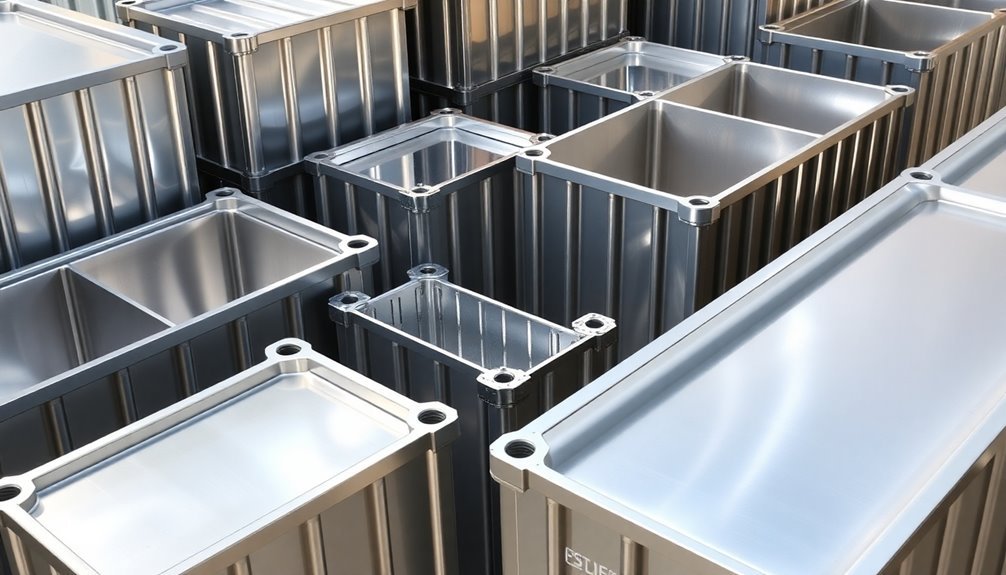
Across the spectrum of bulk conductive storage options, material quality directly influences container pricing.
You'll find conductive plastic containers at the lower end of the price range, starting at $3.43 for small units and reaching $59.28 for larger ESD totes. These offer a cost-effective solution while maintaining necessary ESD protection standards.
For heavy-duty applications, you'll want to take into account fiberglass containers at $62.42 each. They're ideal when you need superior durability and resistance to bending under heavy loads. You can reduce costs substantially through bulk ordering, with prices dropping to $44.42 per unit for orders over 1,000 pieces.
Polypropylene containers provide a middle-ground option, with prices ranging from $3.43 to $40 depending on size. They're particularly effective for storing small sensitive items, and you'll find them available in CAS (Conductive Anti-Static) variants that meet REACH and RoHS compliance standards.
When you need bulk storage solutions, ESD totes range from $27.90 to $96.59, varying by size and design. You'll find substantial savings through volume pricing, making them cost-effective for large-scale storage needs.
Long-Term Investment Analysis
When evaluating long-term storage solutions, you'll find that bulk conductive containers offer significant returns on investment, with the market projected to grow at a 10% CAGR from its $3.4 billion baseline in 2018.
By investing in these containers, you can achieve up to 40% savings in transportation and storage costs, while reducing packaging waste by 30% compared to traditional methods.
The implementation of smart technology in bulk container systems can boost your logistics efficiency by 20-30%, particularly in tracking and inventory management. You'll see substantial cost benefits when ordering in bulk, with ESD container prices dropping from $62.42 per unit to $42.28 when purchasing 2500 or more units.
- Your initial investment will be offset by reduced storage costs through collapsible designs, cutting space requirements by 30%.
- You'll benefit from the growing IBC market, expected to reach $15.42 billion by 2032, driven by e-commerce expansion.
- Your sustainability goals align with these solutions, as FIBCs offer excellent recycling and reconditioning possibilities, meeting increasing environmental regulations.
These factors combine to make bulk conductive containers a strategic long-term investment for your industrial storage needs.
Frequently Asked Questions
Can These Containers Be Stacked When Loaded With Heavy Materials?
Yes, you'll find these containers are specifically designed to stack safely when loaded with heavy materials. Their heavy-duty plastic and fiberglass construction guarantees they won't bend or sag under substantial weight while stacked.
What Is the Recommended Cleaning Frequency for Maintaining ESD Protection?
You'll need to clean your ESD mats daily if they're used frequently, or weekly for sporadic use. Don't skip cleaning, as debris and oil buildup can compromise ESD protection and damage sensitive components.
How Long Do the Containers Retain Their Conductive Properties?
You'll find that conductivity retention varies from 3-5 years with proper maintenance, but you should test regularly. Material quality, usage patterns, and environmental conditions will directly impact how long your containers stay conductive.
Are Custom Container Sizes Available for Specialized Industrial Applications?
Yes, you'll find custom containers available in sizes from 3" x 4" x 2" to 21" x 12" x 12". They're designed to meet your specific industry needs, including specialized compartments and reinforced options.
What Safety Certifications Are Required for Storing Hazardous Materials?
You'll need DOT Hazmat Training, OSHA Hazmat Operations, HAZWOPER, and IATA DGR certifications to store hazardous materials safely. These guarantee you're compliant with handling, storage, and transportation regulations.
In Summary
You'll find that bulk conductive storage containers represent a significant investment that pays off through proper material handling and static protection. When you're calculating total costs, factor in volume discounts, container sizes, and shipping fees. Don't overlook quality ratings and industry certifications – they directly impact long-term value. Choose your distribution channels wisely, and you'll maximize ROI while maintaining ESD compliance.
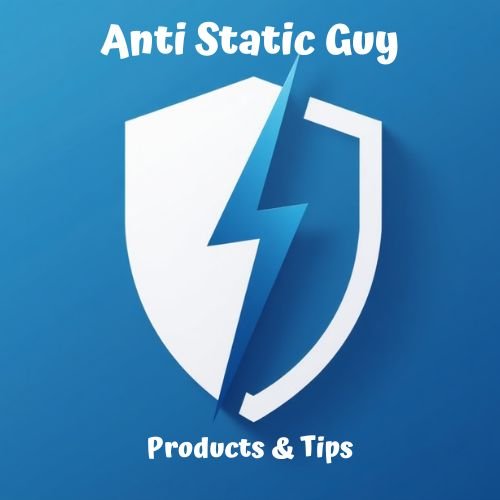
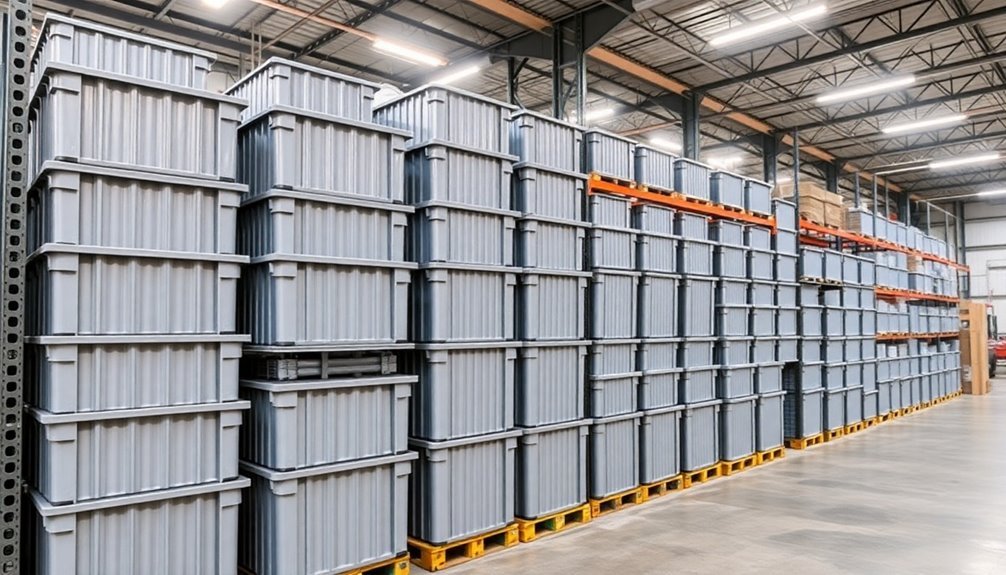



Leave a Reply